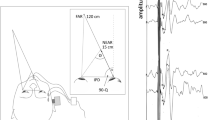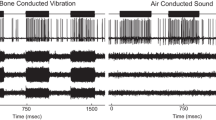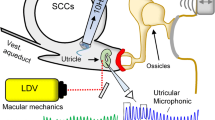Abstract
Natural head movements include angular and linear components of motion. Two classes of vestibulo-ocular reflex (VOR), mediated by the semicircular canals and otoliths (the angular and linear VOR, or AVOR and LVOR, respectively), compensate for head movements and help maintain binocular fixation on targets in space. In this study, AVOR/LVOR interactions were quantified during complex head motion over a broad range of fixation distances at a fixed stimulus frequency of 4.0 Hz. Binocular eye movements were recorded (search-coil technique) in squirrel monkeys while fixation distance (assessed by vergence) was varied using brief presentations of earth-fixed targets at various distances. Stimuli consisted of rotations around an earth-vertical axis and therefore always activated the AVOR. Horizontal and vertical AVORs were assessed when the head was centered over the axis of rotation and oriented upright (UP) and right-side-down (RD), respectively. AVOR gains increased slightly with increasing vergence in darkness, as expected given the small anterior position of the eyes in the head. Combined AVOR/LVOR responses were recorded when subjects were displaced eccentrically from the rotation axis. Eccentric rotations activated the AVOR just as when the head was centered, but added a translational stimulus which generated an LVOR component in response to interaural (IA) or dorsoventral (DV) tangential accelerations, depending on whether the head was UP or RD, respectively. When the head was eccentric and facing nose-out, the AVOR and LVOR produced ocular responses in the same plane and direction (coplanar and synergistic), and response magnitudes increased with increasing vergence. With the head facing nose-in, AVOR and LVOR response components were oppositely directed (coplanar and antagonistic). The AVOR dominated the response when fixation distance was far, and phase was compensatory for head rotation. As fixation distance decreased toward the rotation axis, responses declined to near zero, and when fixation distance approached even closer, the LVOR component dominated and response phase inverted. The same pattern was observed for both horizontal (head UP) and vertical (head RD) responses. The LVOR was recorded directly by rotating subjects eccentrically but in the nose-up (NU) orientation. The AVOR then generated torsional responses to head roll, coexistent with either horizontal or vertical LVOR responses to tangential acceleration when the subject was oriented head-out or right-side-out, respectively. Only the LVOR response components were modulated by vergence. A vectorial analysis of AVOR, LVOR, and combined responses supports the conclusion that AVOR and LVOR response components combine linearly during complex head motion.
Similar content being viewed by others
Author information
Authors and Affiliations
Additional information
Received: 27 February 1997 / Accepted: 18 June 1997
Rights and permissions
About this article
Cite this article
Telford, L., Seidman, S. & Paige, G. Canal-otolith interactions in the squirrel monkey vestibulo-ocular reflex and the influence of fixation distance. Exp Brain Res 118, 115–125 (1998). https://doi.org/10.1007/s002210050261
Issue Date:
DOI: https://doi.org/10.1007/s002210050261




